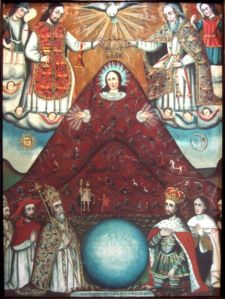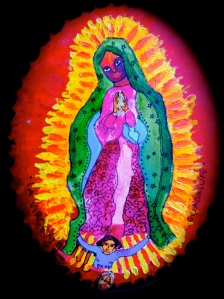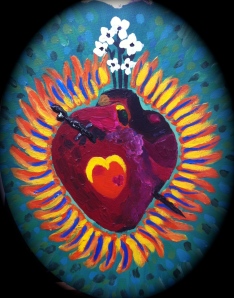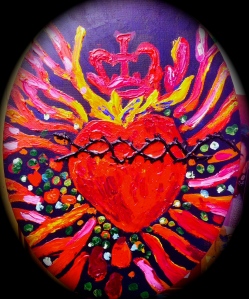Apros Frida’s birthday celebrations. Today I will refer to the second letter of her name: R, and for that I will talk about Religion!Religion is a key topic in Frida’s work. Her paintings are full of Christian symbols: the holy heart, the thorny necklace, the portrait of suffering, the iconography of saints and their stories. This visual language may contradict the political orientation of Frida, as a communist, she may be tempted to deny the existence of God; so why does she reference so many Christian symbols in her work?
For instance, she uses the “thorny crown” as a metaphor of her own suffering. The Christian religion, and in particular, the Catholic interpretation of Christianity, celebrates “suffering” as a form of purification. Hence, the flagellation, the abstinence, chastity and the condemnation of sensual pleasures. In Frida’s case, this pain is both a curse but it may be also a potential salvation. Jesus Christ suffered in life to give us the possibility of salvation and taking into account Frida’s background, it is understandable that this option would become a consolation of her very difficult situation. In other of her images, she appears as a pierced deer, relating to the pierced innocence of the noble animal (also referenced in the Bible). It also alludes to San Sebastian, one of the martyrs of the Catholic imagery, killed by arrows.
Another example of her reference to Christian imagery is her own presence as a ‘virgin’, the most important female deity in the Catholic doctrine. This is a very important point, because in contrast to protestantism, Catholicism offers a key role for women (albeit too restricted to the “chastity” and improbable virginity of this mother) in the form of the Mother of God. But this role is re-created through the process of hybridisation of the indigenous cultures and the catholic doctrine. Many authors have suggested that the popularity of the beloved Virgin de Guadalupe, lies on her physiognomy: instead of a white, blue eyed virgin, this is an earthy, coloured woman, a Latin American deity. Indeed, other Latin American virgins, such as the Virgen del Cerro, in Bolivia, that clearly mixes the image of Virgin Mary with the most earthy deity of la Pacha Mama (Mother Earth).
Virgen del Cerro. Bolivia. Anonymous Virgen de Guadalupe. Acrylic on Oval Canvas. Beatriz Acevedo
It is important to stress the fact that the process of colonization in Latin America, as one of the first cultural enterprises, had at its core two main tools: language and religion. The Kingdom of Spain in the XVI century was the most powerful and was committed to a process of Christianization and unity, after centuries of division, that will finish with the mighty marriage of Isabel de Castilla and Fernando de Aragon. This alliance allowed that territories in the South inhabited by the Islamic culture during more than four centuries, were “recovered”. The fanatic zeal of the King and Queen in establishing the Catholic faith and Christianism, created the infamous Inquisition. At the time of the discovery of this New World, the Catholic hegemony was challenged by the emergence of a new religion: Protestantism, that rejects images and the pompous luxuries of the Catholic priests. In the counter strategy against the growing competition from the Protestants in the North of Europe, the Catholic Church had favoured images, visuality and icons (Acevedo, 2009), and with this impronta they arrived to America. As argued by Serge Gruzinski in his excellent book Images at War: the colonization in America duplicates the West through the intermediary of its institutions, practices and beliefs… The Crown forged new cities, and they sent over its architects, its painters and its musicians. However, the indigenous communities had already their deities and gods, and what happened in this process of “hybridisation” was that the idols and images of the white man, were converted into images of the new mestizo society, where old visions and beliefs were hidden under the new images brought by the colonizers.
In the long run, Latin America, nowadays, speak mainly spanish and we are culturally defined by the Catholic church (in terms of religion, imagery, ways of understanding the world, etc). this is because we say we are all “brothers and sisters” and LatinAmerica can be a continent by itself!
Series Sacred Heart. Acrylic on Oval Canvas. Beatriz Acevedo
(For the exhibition)
Finally, one of the most striking and prevalent image in the Christian imagery is the “Sacred Heart of Jesus”: it can represent gratutitude, love, gratitude for love, repentance for former neglect of love, compassion for Christ’s sufferings, strengthening of love and pruifucation of love… (in Louisa Young‘s The book of the Heart). According to the excellent book of Louisa Young, the heart, in the Christian imagery, is where man and God meet: So the heart of Jesus, who is God and man at the same time, is a point of multiple union (p. 165). Indeed, the fascination with the human dimension of Jesus is better represented through wounds and her heart, proof of his death and resurrection is given in the form of the open wounds and St Thomas is invited to touch them… As described by Young: “A chain reaction develops: the touch, the wound, the connection, the love, the ecstasy, the salvation.” She adds:
“Many were shocked when the film director Derek Jarman fell for St Sebastian and his phacil darts and when Madonna (the pop star, not his mother) suggested that Jesus was sexy; but its been there all along in spadefuls ad nowhere more so than in the sweet piercings and palpitions of the wounded heart.” (p. 179)
Holy Heart. Liquid Acrylics on Hand Made paper. Original by Beatriz Acevedo.
Personally, I have been impressed by the Sacred Heart from an early age. In my grandparents houses there were always Sacred Hearts at the door or in key places, reminding you of this Christian love, the basic teaching of Christianity. Some years later, when I started travelling, I painted a number of Sacred Hearts and I gave them as a token of love and protection to my friends. Near my bed I have two Sacred Hearts, protecting me alongside a number of saints (oh yes, I am totally baroque in that sense!) and thus, the Heart is a constant companion in my journey. One of Frida’s most iconic work: The Two Fridas, points to the importance of the heart. Painted after her divorce of Diego Rivera, the painting is the ambivalent reaction of two Frida’s: one more European (stylised and culturally tamed) and a Mexican Frida, allegedly favoured and celebrated by Diego Rivera. This key reference is central for my interrogation and interpretation of Frida’s influence in my work. The heart as the locus of love and life is also a key symbol in the drawings and homage paid by Gautier to Frida, and also as part of the strong Catholic influence in the French culture.
Being such an important aspect in understanding Frida’s work and the roots of Latin American culture, I’ve started creating some “Sacred Hearts” that will be also presented in the Exhibition. Initially I thought about making them in small canvasses (10 x 15 cm) but I wanted to see how they looked with bright colours. I got inspired by my visit to the Matisse exhibition at Tate Modern (see blog about it) and the result was this. I also did some prints for selling as A4 posters and greeting cards. Now that I framed the originals I feel really satisfied. I hope you like them. Amen!
References:
Louisa Young. 2002. The book of the heart. Flamingo.
Serge Gruzinksi. 2001. Images at War. Duke.














Leave a comment